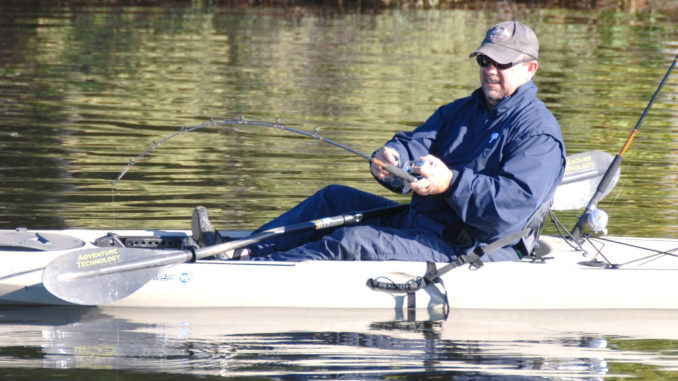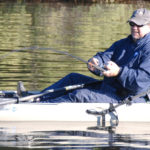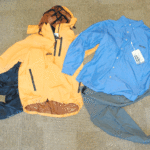
Don’t let cold weather keep your paddle idle
Last December, the mercury hovered right around the 40-degree mark for several days. Two things happened during that early cold front: the water temperatures dropped, and gamefish, both the saltwater and freshwater variety, put on the feed bag.
For experienced anglers, winter fishing can be the best of the year, not only because of smaller crowds on the water, but because as the weather and water temperatures start to drop, baitfish and forage that were easy to find just a few weeks earlier became scarce. And gamefish have to become more active to find food.
The angler who wouldn’t think twice about stepping on board a big power boat during the winter can hardly fathom pulling out the kayak or canoe and heading out to fish. The excuse at the top of the list for why most kayak anglers don’t fish when the weather turns cold? They don’t want to, or are afraid of, getting wet.
That’s a pretty common sentiment, according to Dolphin “Dave” Hamilton, who’s both the manager of Mt Pleasant’s Time Out Sport & Ski and an avid winter kayak angler.
“The winter is really a great time to fish,” he said. “The weather, though colder, is more stable than during the spring and fall and there’s a whole lot less traffic than you’ll see in the summer.”
Hamilton agrees that the stakes can be a little higher. A summertime spill in the water isn’t much concern, but it can be a serious event during the colder months. To judge how serious a threat, Hamilton repeated the Coast Guard’s 100-degree warning.
“Basically, you add the water temperature and the air temperature,” he said. “If the two of them don’t equal at least 100, then there’s a serious threat of exposure to hypothermia if you wind up in the water. They tack on another 50, by saying if you aren’t wearing a life preserver when this happens, there’s at least a 50/50 chance you won’t make it back out of the water.”
PFDs, emergency kits and float plans are necessities no matter when you paddle, but they become mandatory, at least for the sake of safety, when the conditions are below the 100-degree rule.
Hamilton advised that it’s a good idea to pack a waterproof bag with some dry clothes in case you wind up in the water. The bag can be stored below deck to insure it remains dry and out of the way. In the bag, he suggests including a dry fleece hat, wool socks, a spare set of base-layer garments, and some hand/body warmers to help restore warmth.
Dressing for a winter paddling event is not unlike any other outdoor sport, combining layers of clothing that can be added or subtracted as the day wears on. Hamilton breaks down the necessities in three layers: base, mid-level, and outer garments, and he provided this run-down.
Base layer. The layer closest to the skin needs to be lightweight, wicking and made of anything but cotton. “Cotton kills” is the way Hamilton puts it, preferring to use polypropylene or wool undergarments that will wick away moisture when wet, either from sweating or immersion, and still retain its insulating qualities.
“We sell a lot of Patagonia Capilene III in the store,” he said. “It’s marketed as performance long underwear and will do the job of keeping you warm without letting moisture accumulate next to your skin.”
Mid-level. Hamilton’s suggestions for mid-level clothing include a wide array of fleece or wool garments – anything but a pair of blue jeans, which are cotton and will lose any insulating qualities when wet and hold moisture to the skin, sucking away body heat.
“Again, Patagonia and North Face have loads to choose from,” he said. “Stuff like a Patagonia Regulator fleece is a good choice, or if you prefer a wool sweater, that works too. You want something that can be used as an outer layer when you take off the water repellent stuff.”
Outer wear. A quality to look for in a good outer-layer garment is a waterproof shell that still allows air to circulate, to let heat out when paddling. Hamilton said under extreme conditions, some anglers may invest in a dry suit more suited for northern climate, but he offers there are Gore-Tex garments that fit the bill nicely in South Carolina’s milder climate.
“I prefer the name splash wear, because that’s what you need,” said Hamilton. “That’s stuff like the paddling garments offered by manufacturers like Immersion Research made for kayaking in cold weather.”
Finally, Hamilton cautions not to forget the head, hands and feet. The extremities are the most likely to be in the water when paddling and more heat is lost from the head than the rest of the body combined.
“I like the Stohlquist paddling gloves and a pair of Chota Mukluks over a pair of wool socks for my feet,” he said. “They’re waterproof about knee-high and have a non-marking grip sole.”
The angler tops it off with a fleece or wool toboggan.
“Now you’re got no excuse to get out there and catch some of those tightly schooling redfish down here at the coast or some chunky largemouth or schooling striped bass over in the freshwater,” he said.






Be the first to comment